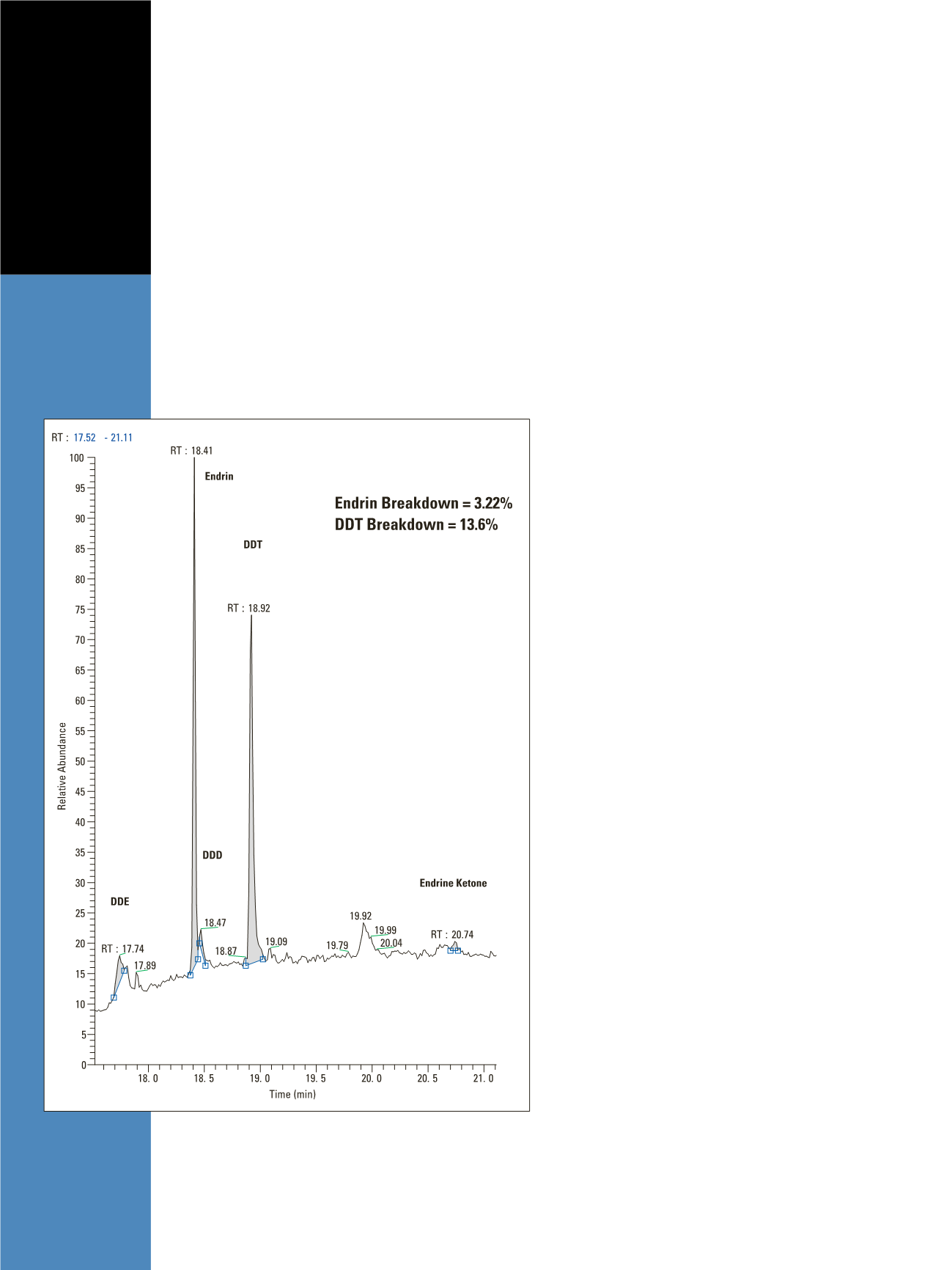
Injection
The ITQ 700 is paired with the Thermo Scientific FOCUS
GC gas chromatograph, which is a single-channel GC
with a standard split/splitless (SSL) injection port. The SSL
inlet temperature was set to 250 °C. A 5 mm ID splitless
liner with a volume of 1.6 mL was selected for the surged
pressure injection. For the surge splitless injection, the
inlet pressure was held at an elevated pressure of 250 kPa
for the 0.5 minute injection (splitless) time. This technique
reduces the vapor cloud of a 2 µL injection from 0.37 mL to
0.19 mL. At an elevated injection flow rate of 4.6 mL/ min,
the liner was swept several times during injection. The target
compounds moved through the inlet so rapidly that they
had less time to interact with the inside walls of the liner.
This minimized the amount of breakdown of the more
fragile pesticides.
A Performance Solution consisting of endrin and
4,4'-DDT was analyzed as a daily check to determine
system activity. The analysis of endrin, DDT, and their
breakdown products as part of daily quality control can
alert the analyst that the system has developed active sites
and maintenance is needed. Without performing a breakdown
analysis the laboratory may need to continually maintain
the equipment and replace consumables, even when it may
not be needed. Monitoring breakdown can decrease the
cost of running the analysis and save significant amounts
of time.
Endrin breakdown is determined by adding up the
response for the two breakdown products: endrin aldehyde
and endrin ketone and dividing by the total response for
the breakdown products and endrin in percent. The
breakdown products of DDT are DDE and DDD and are
calculated similarly. The breakdown check results showed
< 15% breakdown for both compounds on a daily basis.
For routine use the liner would be changed when the
breakdown of either compound reaches > 20%. The injection
port liner tested showed very good results over a long
period of time without the need for maintenance (Figure 3).
Separation
Chromatographic separation was achieved by using a
35% diphenyl/65% dimethyl polysiloxane column
(0.25 mm x 30 meter, and a film thickness of 0.25 µm
with a 5 m guard column). This column was chosen to
improve the resolution of the more polar compounds.
Some interactions within the stationary phase showed a
loss of some pesticides at concentrations below 100 pg.
The oven was programmed as follows: Initial Temp: 40 °C,
1.5 min, 25 °C/min to 150 °C, 0.0 min, 5 °C/min to 200 °C,
7.5 min, 25 °C/min to 290 °C with a final hold time of
12 min and a constant column flow rate of 1 mL/min. The
entire set of instrument parameters is listed in Table 2.
Detection
The detection of the pesticides was performed using the
ITQ 700 ion trap mass spectrometer with optional MS
n
mode and a variable damping gas option. The MS/MS
scan mode offers significantly enhanced selectivity over
scanning modes such as full scan and selected ion
monitoring (SIM). The ITQ 700 operated in the MS/MS
mode generates unique product ion spectra by collision
induced fragmentation of each of the detected pesticides.
Because of the highly effective elimination of matrix
interfering ions, more accurate results are produced at the
lower levels. The MS
n
parameters for the ITQ 700 are
listed in Table 3. Figures 4 and 5 show a comparison
between a Full Scan TIC and MS/MS extracted ion profile.
Page 4 of 8
Figure 3: System performance check analysis demonstrating endrin
breakdown < 5% and DDT breakdown < 15%


